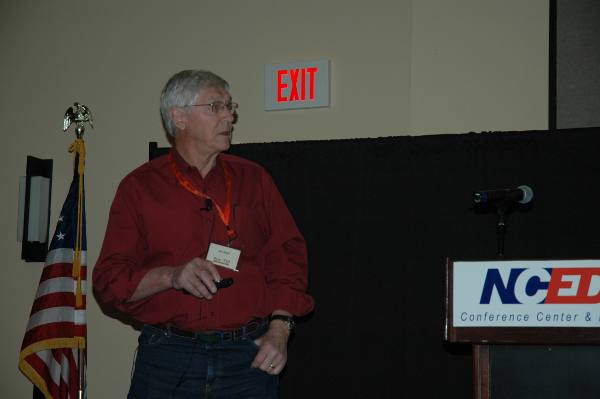
Intense tillage may be the worst thing farmers can do for the health of their soil, and maintaining as much residue as possible aids in improving and maintaining soil quality.
Removing residue from cropland also removes nutrients that must be replaced to improve or maintain soil fertility, quality and health, says a Nebraska crop consultant.
“Anything we take off the land removes nutrients,” says Ray Ward, Ward Laboratories, Kearney, Nebraska.
Ward, speaking at the recent No-till Oklahoma Conference in Norman, said conservation tillage helps minimize the amount of nutrients lost from the soil from crop production. “For many years we have been pulling nutrients off the land and putting them back on. We haul off major nutrients as well as trace materials. Often, salesmen try to sell materials to farmers to spray back on. But a plant takes up nutrients from the roots if fertility is adequate. We may sometimes need to add chloride.”
Keeping the soil nutrient level in balance is the goal. And maintaining old crop residue or cover crop vegetation is an advantage. Removing wheat straw, for example, takes away 12 pounds of nitrogen, 2.3 pounds of phosphorus and 29 pounds of potassium, plus 4 pounds of sulfur. “I don’t think a farmer should ever take any wheat straw off the land,” Ward said.
A 100-bushel per acre corn crop removes 70 pounds of nitrogen, 33 pounds of phosphorus, 23 pounds of potassium, 9 pounds of sulfur and 0.1 pounds of zinc. A 45-bushel soybean yield takes 153 pounds of nitrogen, 35 pounds of phosphorus, 54 pounds of potassium, 8 pounds of sulfur and .09 pounds of zinc.
“If we don’t put those nutrients back with commercial fertilizers we will need to add manures or bio-solids,” Ward said. Mobile nutrients, such as nitrogen, may be replaced every year, as needed. Immobile nutrients—phosphorus and potassium—are built up and maintained.
Ward said long-term and short-term nutrient loss plans require “distinctly different approaches. Farmers with limited resources may not be able to afford to build nutrients,” he said. But they still need to maintain the proper balance.
Biggest yield, he said, comes from the highest testing soils. “If soil tests high and still does not yield, something is wrong. Get nutrient levels in balance.”
Farmers may credit soil nitrogen that is available to plants to help fill soil test recommendations. “Also, credit any legume contribution to the nitrogen recommendation.”
He recommends applying sulfur when tests for sulfate are low. “But we do not have to build the sulfur level.”
He said some nutrient replacement maybe tricky. “Sometimes there is a small difference between deficiency and toxicity.”
With no-till production, Ward recommends “knifing in nitrogen. Do not use a ‘weed and feed’ program for nitrogen. A second alternative is to stream on UAN or broadcast urea. Split applications may be necessary on sandy soils.”
Phosphorus and other nutrients may be broadcast or banded.
Ward said aluminum problems sometimes show up in a lot of Oklahoma soils and may need lime when pH levels are low. “When it’s dry, soil pH gets low. As water leaves the soil, salts build up and lower the pH.”
pH issues
High pH is a different issue. “We have no easy fix for high pH soils. Farmers may need to select an adaptable crop.”
Nutrient cycling is an important concern, Ward said. “Anytime we remove grain or forage from the land, we remove nutrients. High yields remove more nutrients that must be replaced. We get some carbon and nitrogen from the air. We have to get more from soil minerals, decomposing organic matter, manures and fertilizers. I see nothing wrong with these.”
Some people do. He objects to “non-ag magazines” and other sources complaining that such farming practices are not sustainable. “That makes me mad,” he said. “We are doing much better at conserving soil.”
Like what you're reading? Subscribe to Southwest Farm Press Daily and get the latest news right to your inbox.
Practices such as rotation and cover crops are helping with conservation. Cover crops, for example, recycle nutrients such as nitrogen and calcium back to the soil surface. “Soil organic matter is not just carbon; we have to build up organic matter to get all the other nutrients. Most sulfur is held in organic matter. The idea is to build soil organic matter to improve soil quality and health.”
Increasing organic matter content improves productivity, enhances infiltration, adds to soil stability and builds structure. Reduced tillage preserves that organic matter. “The No. 1 environmental enemy in production agriculture is intensive tillage,” Ward said. “Soil carbon is the keystone that holds everything together—soil physical, biological, and chemical processes and properties.”
He said preserving soil is essential to feeding the world. “If we can produce enough food for 2050, what can we do after that? Can we continue to do it?”
He’s convinced we can, but conserving the soil will be an essential part of the process. “We may move slowly.”
A critical aspect of conservation will be eliminating tillage and maintaining cover.
You may also like:
Panhandle crop production offers challenges to Oklahoma producers
About the Author(s)
You May Also Like






